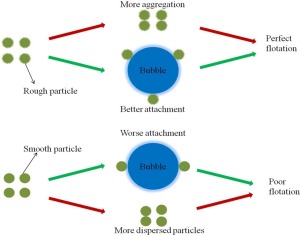当前位置:
X-MOL 学术
›
Colloids Surf. A Physicochem. Eng. Aspects
›
论文详情
Our official English website, www.x-mol.net, welcomes your
feedback! (Note: you will need to create a separate account there.)
Investigation on the influence of surface roughness on magnetite flotation from the view of both particle-particle and bubble-particle interactions
Colloids and Surfaces A: Physicochemical and Engineering Aspects ( IF 4.9 ) Pub Date : 2020-06-01 , DOI: 10.1016/j.colsurfa.2020.124681 Zhanglei Zhu , Wanzhong Yin , Huili Han , Shaohang Cao , Bin Yang , Donghui Wang
Colloids and Surfaces A: Physicochemical and Engineering Aspects ( IF 4.9 ) Pub Date : 2020-06-01 , DOI: 10.1016/j.colsurfa.2020.124681 Zhanglei Zhu , Wanzhong Yin , Huili Han , Shaohang Cao , Bin Yang , Donghui Wang

|
Abstract It is well known that surface roughness of mineral particles has a significant influence on their flotation behaviors. In this investigation, magnetite was ground in rod and ball mills to generate particles with similar dimension and shape but varying degree of surface roughness, which was quantified using Atomic Force Microscopy (AFM). The influence of surface roughness on the floatability of magnetite particles was performed by flotation tests using an XFG flotation machine. Flotation tests indicated magnetite particles possessed higher surface roughness had higher flotation recovery and larger flotation rate constant. The aggregation behaviors of different rough magnetite particles were compared for the first time via an optical microscopy. Results of the optical microscopic tests revealed that there were a large number of aggregations in the system of particles with higher surface roughness. A proposed model was deduced with the parameters carefully calculated (not arbitrarily selected) to analyze the bubble-particle interaction energy using an Extended DVLO (Derjaguin–Landau–Verwey–Overbeek) theory. The theoretical interaction energy points to lowering energy barrier when magnetite particles are covered with 28.03 nm asperities as compared to 9.47 nm asperities. The effect of surface roughness on mineral flotation was investigated from the view of both particle aggregations and energy barrier of bubble-particle attachment for the first time, which are the primary causes for differences in flotation performance.
中文翻译:

从颗粒-颗粒和气泡-颗粒相互作用的角度研究表面粗糙度对磁铁矿浮选的影响
摘要 众所周知,矿物颗粒的表面粗糙度对其浮选行为有重要影响。在这项研究中,磁铁矿在棒磨机和球磨机中研磨以产生具有相似尺寸和形状但表面粗糙度不同程度的颗粒,使用原子力显微镜 (AFM) 对其进行量化。使用XFG浮选机通过浮选试验来进行表面粗糙度对磁铁矿颗粒可浮性的影响。浮选试验表明,磁铁矿颗粒具有较高的表面粗糙度,具有较高的浮选回收率和较大的浮选速率常数。首次通过光学显微镜比较了不同粗磁铁矿颗粒的聚集行为。光学显微测试结果表明,在具有较高表面粗糙度的颗粒体系中存在大量聚集体。使用扩展的 DVLO(Derjaguin-Landau-Verwey-Overbeek)理论,通过仔细计算(不是任意选择)参数推导出建议的模型,以分析气泡 - 粒子相互作用能。与 9.47 nm 的粗糙结构相比,当磁铁矿颗粒被 28.03 nm 的粗糙结构覆盖时,理论相互作用能表明能量势垒会降低。首次从颗粒聚集和气泡-颗粒附着的能垒两个角度研究了表面粗糙度对矿物浮选的影响,这是导致浮选性能差异的主要原因。使用扩展的 DVLO(Derjaguin-Landau-Verwey-Overbeek)理论,通过仔细计算(不是任意选择)参数推导出建议的模型,以分析气泡 - 粒子相互作用能。与 9.47 nm 的粗糙结构相比,当磁铁矿颗粒被 28.03 nm 的粗糙结构覆盖时,理论相互作用能表明能量势垒会降低。首次从颗粒聚集和气泡-颗粒附着的能垒两个角度研究了表面粗糙度对矿物浮选的影响,这是导致浮选性能差异的主要原因。使用扩展的 DVLO(Derjaguin-Landau-Verwey-Overbeek)理论,通过仔细计算(不是任意选择)参数推导出建议的模型,以分析气泡 - 粒子相互作用能。与 9.47 nm 的粗糙结构相比,当磁铁矿颗粒被 28.03 nm 的粗糙结构覆盖时,理论相互作用能表明能量势垒会降低。首次从颗粒聚集和气泡-颗粒附着的能垒两个角度研究了表面粗糙度对矿物浮选的影响,这是导致浮选性能差异的主要原因。与 9.47 nm 的粗糙结构相比,当磁铁矿颗粒被 28.03 nm 的粗糙结构覆盖时,理论相互作用能表明能量势垒会降低。首次从颗粒聚集和气泡-颗粒附着的能垒两个角度研究了表面粗糙度对矿物浮选的影响,这是造成浮选性能差异的主要原因。与 9.47 nm 的粗糙结构相比,当磁铁矿颗粒被 28.03 nm 的粗糙结构覆盖时,理论相互作用能表明能量势垒会降低。首次从颗粒聚集和气泡-颗粒附着的能垒两个角度研究了表面粗糙度对矿物浮选的影响,这是导致浮选性能差异的主要原因。
更新日期:2020-06-01
中文翻译:

从颗粒-颗粒和气泡-颗粒相互作用的角度研究表面粗糙度对磁铁矿浮选的影响
摘要 众所周知,矿物颗粒的表面粗糙度对其浮选行为有重要影响。在这项研究中,磁铁矿在棒磨机和球磨机中研磨以产生具有相似尺寸和形状但表面粗糙度不同程度的颗粒,使用原子力显微镜 (AFM) 对其进行量化。使用XFG浮选机通过浮选试验来进行表面粗糙度对磁铁矿颗粒可浮性的影响。浮选试验表明,磁铁矿颗粒具有较高的表面粗糙度,具有较高的浮选回收率和较大的浮选速率常数。首次通过光学显微镜比较了不同粗磁铁矿颗粒的聚集行为。光学显微测试结果表明,在具有较高表面粗糙度的颗粒体系中存在大量聚集体。使用扩展的 DVLO(Derjaguin-Landau-Verwey-Overbeek)理论,通过仔细计算(不是任意选择)参数推导出建议的模型,以分析气泡 - 粒子相互作用能。与 9.47 nm 的粗糙结构相比,当磁铁矿颗粒被 28.03 nm 的粗糙结构覆盖时,理论相互作用能表明能量势垒会降低。首次从颗粒聚集和气泡-颗粒附着的能垒两个角度研究了表面粗糙度对矿物浮选的影响,这是导致浮选性能差异的主要原因。使用扩展的 DVLO(Derjaguin-Landau-Verwey-Overbeek)理论,通过仔细计算(不是任意选择)参数推导出建议的模型,以分析气泡 - 粒子相互作用能。与 9.47 nm 的粗糙结构相比,当磁铁矿颗粒被 28.03 nm 的粗糙结构覆盖时,理论相互作用能表明能量势垒会降低。首次从颗粒聚集和气泡-颗粒附着的能垒两个角度研究了表面粗糙度对矿物浮选的影响,这是导致浮选性能差异的主要原因。使用扩展的 DVLO(Derjaguin-Landau-Verwey-Overbeek)理论,通过仔细计算(不是任意选择)参数推导出建议的模型,以分析气泡 - 粒子相互作用能。与 9.47 nm 的粗糙结构相比,当磁铁矿颗粒被 28.03 nm 的粗糙结构覆盖时,理论相互作用能表明能量势垒会降低。首次从颗粒聚集和气泡-颗粒附着的能垒两个角度研究了表面粗糙度对矿物浮选的影响,这是导致浮选性能差异的主要原因。与 9.47 nm 的粗糙结构相比,当磁铁矿颗粒被 28.03 nm 的粗糙结构覆盖时,理论相互作用能表明能量势垒会降低。首次从颗粒聚集和气泡-颗粒附着的能垒两个角度研究了表面粗糙度对矿物浮选的影响,这是造成浮选性能差异的主要原因。与 9.47 nm 的粗糙结构相比,当磁铁矿颗粒被 28.03 nm 的粗糙结构覆盖时,理论相互作用能表明能量势垒会降低。首次从颗粒聚集和气泡-颗粒附着的能垒两个角度研究了表面粗糙度对矿物浮选的影响,这是导致浮选性能差异的主要原因。











































 京公网安备 11010802027423号
京公网安备 11010802027423号